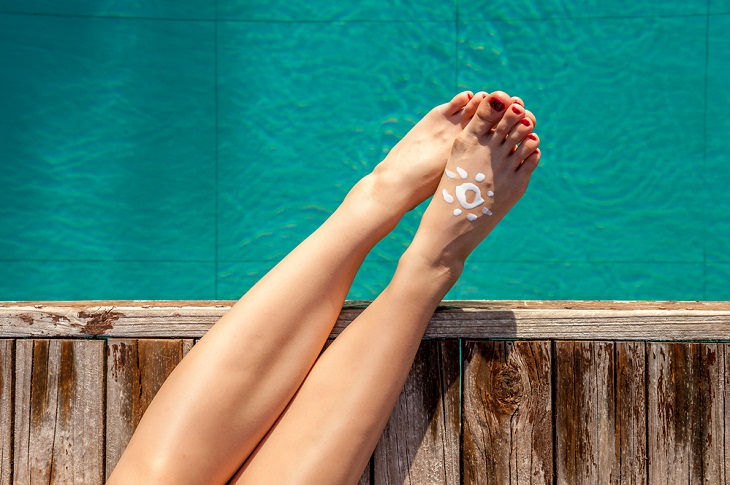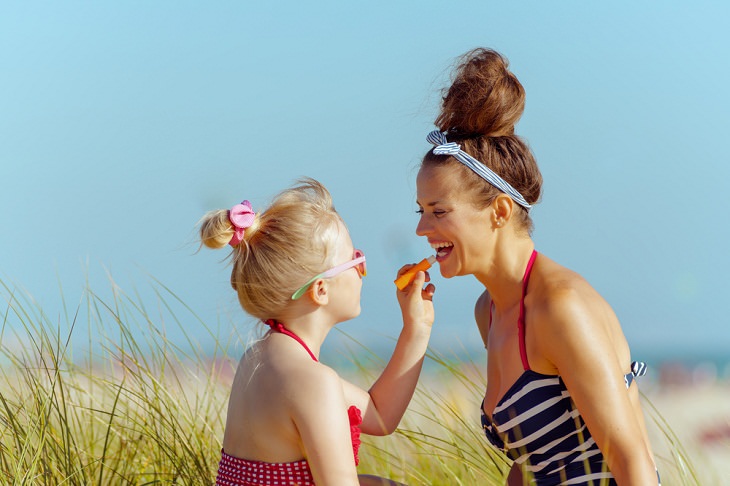However, while you may be slathering your skin with sunscreen, are you sure you are protecting all the critical parts of your body? Usually, we tend to apply sunscreen lotion on our face, hands, arms, legs, and chest. But dermatologists say that there are some common portions on our bodies that many people forget to apply sunscreen to. Let’s take a look at some of them.
1. Ears
Research has shown that skin cancer can occur in any part of the ear. This includes the middle part (also known as the conchal bowl), which is reasonably protected from the sun. Precancerous abrasions too are commonly found in this area. So even if you are wearing a hat or a baseball cap while being out in the sun, your ears might be exposed. Make sure to thoroughly cover the top, back, and middle parts of the ears with sunscreen. This is particularly essential for people with shorter hair as their ears have higher chances of being exposed to the sun.
2. Eyelids
Dermatologists say that eyelids are possibly the most overlooked when it comes to sun protection. It’s estimated that almost 3% of all skin cancers develop here. You can, of course, protect your eyelids in summer by wearing sunglasses. But what if you forgot them? Or what if you fall asleep on the beach without them? That can be dangerous as your eyelids can get severely burned. Experts recommend getting an ophthalmologist-approved SPF 30 lotion and applying it gently on this delicate area.
3. The tops of your feet
While the soles of our feet are protected against the sun’s ultraviolet light with a thick layer of dead skin cells, the top part tends to be highly exposed during the summer season as many of us prefer to wear sandals, flip flops, or skin-bearing footwear when out instead of shoes. And that’s one part that often gets neglected when we are putting on sunscreen. So if you don’t want to have a nasty red and painful sunburn on the top of your feet, or get some ugly sandal or shoe pattern marks there, always cover the area properly with sunscreen.
4. Scalp
Your hair does provide a bit of protection from UV rays, but you still need to be extra careful. Particularly if you have thinning hair or are bald. Getting a sunburn on your head can be quite painful and annoying as the scalp begins to peel and it looks like you have a horrible case of dandruff. It’s hence better to protect yourself by spraying some sunscreen on the top of your head whenever you plan on being outside for a long time. Sure, it might make your hair a little greasy and goopy, but at least you will have that extra layer of protection. You can wear a hat, of course, but not everyone is comfortable with that.
Dermatologists recommend a gel-based sunscreen to more effectively cover and protect this area.
5. Around the eyes and lips
Apart from protecting your eyelids with sunscreen, it’s equally important to apply the lotion around the eyes and lips. These are vulnerable areas and are often neglected while applying sunscreen as people usually focus on the cheeks, the nose, and the forehead. But this often leads to cases of fine and ugly lines around the eyes and the lips in many people after their day out in the sun.
According to the Skin Cancer Foundation, the majority of lip cancers appear on the lower lip, and the leading risk factor for it is UV radiation from the sun. Lip balms with SPF protection should help. Or simply coat your lips finely with a good sunscreen.
6. The lower leg
The lower part of the leg doesn't sunburn frequently and that’s why it’s usually the last area that people put sunscreen on or just neglect it. However, doctors report that a very high rate of skin cancer occurs in the lower leg. This happens because it tends to get exposed with shorts and skirts. While rubbing sunscreen on your lower legs, be sure to also cover the back of your knees as that’s another tender spot that’s commonly forgotten.
7. Around the armpits
Another place that’s usually overlooked while wearing sunscreen is the armpits. The folds of skin on the shoulder and arm area surrounding the armpits are also often forgotten during sunscreen application. But getting a sunburn there would be a super painful experience as you wouldn’t be able to even move your hands around comfortably. Even if you do apply the lotion to your armpits and underarms, it can wear off in the summer because of sweating. So remember to keep applying sunscreen to these areas throughout the day.
Related: The Do’s and Don’ts of Healing a Sunburn
Bottom Line:
Skin cancers can occur anywhere. Even in the areas that don’t get sun. So never forget to put a thick layer of sunscreen on all exposed skin whenever you head out on a hot summer day. If you are outside for a long time, then it’s important to reapply the lotion about every two hours. The Centers for Disease Control and Prevention (CDC) recommends using a broad-spectrum sunscreen with an SPF of 15 or higher. Also, make sure you check the sunscreen’s expiration date before using it.
Share this article with your loved ones!



